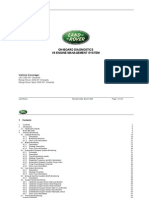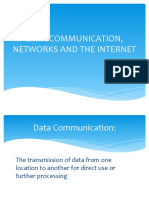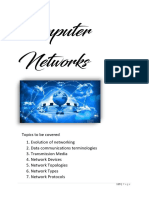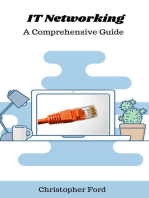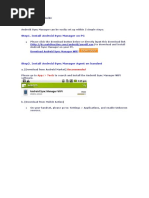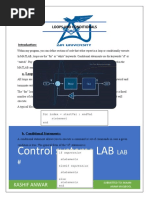Immaculate Conception High School Information Technology - Grade 11
Uploaded by
Zonya Kelly KaeImmaculate Conception High School Information Technology - Grade 11
Uploaded by
Zonya Kelly KaeImmaculate Conception High School Information Technology Grade 11
Section 4 A: Internet and Communications Technology Specific Objective 1: Use terms associated with data communications and networks a) Data Communication(DC) : This is the process of transferring data from one computer system to another for direct use or for further processing. Protocols define the rules for communication so that sender and receiver can coordinate their activities. A DC system consists of hardware and software and communication facilities. Communication can cover a small or large area. Data in a DC is moved from one area to another via data communication channels or links. Channels are classified according to bandwidth. b) Network: A group of connected computers that exchange information and share equipment. A network is a communication system that allows users to access hardware and software resources on other computers and exchange messages with one another. It allows users to share resources on their own system or access shared resources on other systems. c) Types of networks i) Local area network(LAN): A type of computer network where two or more computers are directly linked within a small area such as a classroom, home or building. ii) Wide area network(WAN): A type of computer network where two or more computers are connected/linked over a wide geographical area such as a country or even across the world. iii) Metropolitan area network(MAN): A type of computer network where two or more computers are connected within a city, a university campus or other areas other than a building. The scope of a MAN is between a LAN and a WAN. A man can be owned by a company but is usually used by many organizations. d) Types of transmission media: When any two devices need to communicate, they have to agree on a number of points before the conversation can begin. The first point of agreement is physical: Will they talk over wires, or through some form of wireless signals? If they use wires, how many are required -- one, two, eight? What is the transmission speed? i) Cable/wired media (1) Twisted pair: This cable consists of copper-core wires surrounded by an insulator. Two wires are twisted together to form a pair. This is a cheap cabling used to connect computers and peripherals. Twisted-pair cabling does not allow very fast transmission, so it is not suitable for sending large amounts of data. It is used in small LANs for offices and homes. (2) Coaxial: This cable is more expensive than twisted pair and consists of a solid copper core surrounded by an insulator, a combination shield and ground wire, and an outer protective jacket. Coaxial cables carry electric current at radio frequencies. It is used for cable television and broadband Internet connections. (3) Fibre-optic: This is the most robust, efficient and expensive cable. It provides for very fast and reliable form of data transmission. It consists of a center glass core through which light waves propagate. Although light travels in straight lines, a light beam bounces off the sides of the fibre along its length so the cable can be quite flexible. Fibre-optic cable is available with a metal core for strength if the cable will be hung over distances. ii) Wireless media: Radio and Microwave signals are used to send and receive data. (1) Satellite: Satellite communication systems consist of Earth-orbiting communications platforms that receive and retransmit microwave signals from one earth-based station to another. This is a good way to transmit data wirelessly over very large distances, but it would be needlessly expensive for a small network. (2) Microwave: Microwaves are short-wavelength, high-frequency signals that occupy the electromagnetic spectrum 1,000 MHz (1 GHz) to 1,000 GHz (1 terahertz). This is just above the radio frequency range and just below the infrared range. The entire range is huge, but much of it is not used for data communications, especially at the high-end due to water absorption. (3) Infra-red: This is short-wave electromagnetic radiation that falls between radio waves and visible light. Infrared can't be seen, but it can be felt as heat given a strong energy source. It can be used to transmit data fairly quickly over a short range. Most people are familiar with infrared as implemented in remote control devices. Infrared is used in most television remote control systems. Infrared communications are fairly reliable and don't cost very much to build into a device. To use infrared communication, each device must have an infrared port, the infrared ports must be in line of sifht and they must be fairly
close to each other, usually within 5 metres. Infrared Data Association (IrDA) is the group responsible for developing the technology. iii) Wireless network technology: (1) Bluetooth: Bluetooth networking transmits data via low-power radio waves. It transmits signals over short distances. Bluetooth doesn't require line of sight between communicating devices. The walls in your house won't stop a Bluetooth signal, making the standard useful for controlling several devices in different rooms. Bluetooth can connect up to eight devices simultaneously. It is mainly used to send data between devices such as between cell phones, or a cell phone and headset, or between a digital camera and a laptop. Bluetooth systems create a personal-area network (PAN). (2) Wi-Fi: Wireless networking, also called WiFi, uses radio waves. A Wi-Fi enabled device such as a PC, game console, mobile phone, MP3 player or PDA can connect to the Internet when within range of a wireless network connected to the Internet. Most modern computers have wireless receivers so they can easily join a wireless network, often called a Wi-Fi network. Wi-Fi is often used to set up LANs because: (a) it can transmit data quickly, (b) no cables are needed to add a device to the network, (c) the range is high, and (d) devices do not need direct line of sight with each other or the wireless transmitter. e) Hotspot/Access point: A hotspot is a place where you can access Wi-Fi. Hotspots are very common today and can be found at restaurants, hotels, libraries, schools, airports, offices, hospitals, and banks so that individuals who have a laptop with a wireless receiver can access the Internet. f) Modem(short for MODulator / DEModulator): A communication device that sends and receives data. It is used to convert digital data from the computer into analogue data that can be transmitted over the telephone line. When the data gets to the other end, another modem converts the analogue data back into digital data so that the computer at that end can process it.
g) Bandwidth (capacity of the communications channel): This refers to the volume of data that can be transmitted in a given time. The wider the bandwidth the more data it can transmit. Think of bandwidth as a pipe and data as water flowing through the pipe into a bucket. If the pipe is very narrow, the water will pour into the bucket in a thin stream, so the bucket will take a long time to fill. If the pipe is wide, the bucket will fill up quicker. i) Narrowband: channel which is almost obsolete can transmit data at slow speeds of between 10 and 30 characters per second (cps). ii) Voiceband: channel can transmit data at the rate of 1000 to 8000 cps. A telephone line is voice-band, and is one of the most widely used methods of transferring data. iii) Broadband: channel can transmit large volumes of data at speeds of over 100000 cps. Uses fibre optic, microwave, satellites and coaxial cables. h) Communication modes: the lines that transmit data can also be classified according to the direction which data flows through them i) Simplex: Data is transmitted in one direction only. You can send or receive data, but not both. When you watch TV or listen to the radio you receive the broadcast signal but you do not need to send any data. ii) Half duplex: Data is sent and received but not at the same time. You cannot receive data while you send data, and vice versa. Walkie-talkies use half-duplex communications. iii) Full-Duplex: Data is sent and received simultaneously. Phone lines use full duplex which enables two-way communication between two or more persons carrying on a conversation. i) Point-to-point: This occurs when data is sent directly from one device to exactly one other. On a point-to-point link, there is no contention for the cable because it connects only the sender and receiver, not a number of shared devices. Broadcast: A method of sending a signal where multiple parties may hear a single sender. It also refers to a type of networking that is done on shared-media networks where multiple nodes are attached to the same LAN. It is a one-to-many method of transmitting information. Think of radio and TV signals being broadcast such that all with the appropriate equipment can receive the signal.
j)
2) Specific Objective 2: Distinguish among Internet, intranet and extranet Internet is a global network of smaller networks connected together by a public network. The Internet is often called the information superhighway.
An intranet is an internal network that implements Internet and Web technologies such as Web servers and Web browsers that use HTTP and HTML. An extranet is an intranet that has been extended outside the company to a business partner, with transmissions going over the Internet or across private lines.
You might also like
- On-Board Diagnostics V8 Engine Management System: Vehicle CoverageNo ratings yetOn-Board Diagnostics V8 Engine Management System: Vehicle Coverage124 pages
- CBSE Class 12 Computer Science - NetworkingNo ratings yetCBSE Class 12 Computer Science - Networking10 pages
- Understanding Data Communications and NetworksNo ratings yetUnderstanding Data Communications and Networks3 pages
- Introduction To The Network Communication TechnologyNo ratings yetIntroduction To The Network Communication Technology4 pages
- Data Communication, Networks and The InternetNo ratings yetData Communication, Networks and The Internet45 pages
- COMMUNICATION AND NETWORK CONCEPTS - Students 24.4.24No ratings yetCOMMUNICATION AND NETWORK CONCEPTS - Students 24.4.2424 pages
- Internet: Short Cut To Remember Wet Figce WWW E-Mail Telnet FTP Intranet Gopher Chat Group ExtranetNo ratings yetInternet: Short Cut To Remember Wet Figce WWW E-Mail Telnet FTP Intranet Gopher Chat Group Extranet15 pages
- Computer Networks & Internet TechnologiesNo ratings yetComputer Networks & Internet Technologies13 pages
- Data Communication: Delivering Information Anywhere and AnytimeNo ratings yetData Communication: Delivering Information Anywhere and Anytime8 pages
- Topic: Communication and Networks: Lecture PreviewNo ratings yetTopic: Communication and Networks: Lecture Preview10 pages
- Chapter 8 - Communications and NetworksNo ratings yetChapter 8 - Communications and Networks44 pages
- Thousands of Bits Per Second (KBPS) To Millions of Bits Per Second (MBPS) andNo ratings yetThousands of Bits Per Second (KBPS) To Millions of Bits Per Second (MBPS) and6 pages
- Computer Science Chapters 11 & 12 Short Note Live NoteNo ratings yetComputer Science Chapters 11 & 12 Short Note Live Note20 pages
- OPOW6St - Three-Phase Directional Overpower Protection Stage 1 (OPOW6St1) Stage 2 (OPOW6St2) Stage 3 (OPOW6St3)No ratings yetOPOW6St - Three-Phase Directional Overpower Protection Stage 1 (OPOW6St1) Stage 2 (OPOW6St2) Stage 3 (OPOW6St3)16 pages
- Fly The Maddog X Operations Manual Volume 2No ratings yetFly The Maddog X Operations Manual Volume 2177 pages
- Step1. Install Android Sync Manager On PCNo ratings yetStep1. Install Android Sync Manager On PC5 pages
- Analysis and Software Implementation of A Robust Synchronizing PLL CircuitNo ratings yetAnalysis and Software Implementation of A Robust Synchronizing PLL Circuit19 pages
- Final Year Project Presentation Blood Donation AppNo ratings yetFinal Year Project Presentation Blood Donation App28 pages
- Khan, 2023 - Review Design and Optimization of Lithium-Ion BatteryNo ratings yetKhan, 2023 - Review Design and Optimization of Lithium-Ion Battery33 pages
- CS 505 - Linux Laboratory Manual - Final - 1659164997No ratings yetCS 505 - Linux Laboratory Manual - Final - 165916499729 pages
- Using Key Performance Indicators in Construction Project LiteratureNo ratings yetUsing Key Performance Indicators in Construction Project Literature7 pages
- Magnetohydrodynamic (MHD) Generator: Sarah Herder Aubrey Spilde Margaret ZahllerNo ratings yetMagnetohydrodynamic (MHD) Generator: Sarah Herder Aubrey Spilde Margaret Zahller13 pages
- ++latur Architects NCT 10020039 2 November 2023No ratings yet++latur Architects NCT 10020039 2 November 20233 pages
- Weibull Analysis in Software Reliability EngineeringNo ratings yetWeibull Analysis in Software Reliability Engineering3 pages
- Analysis of RIP, OSPF, and EIGRP Routing": Synopsis ON "No ratings yetAnalysis of RIP, OSPF, and EIGRP Routing": Synopsis ON "9 pages

